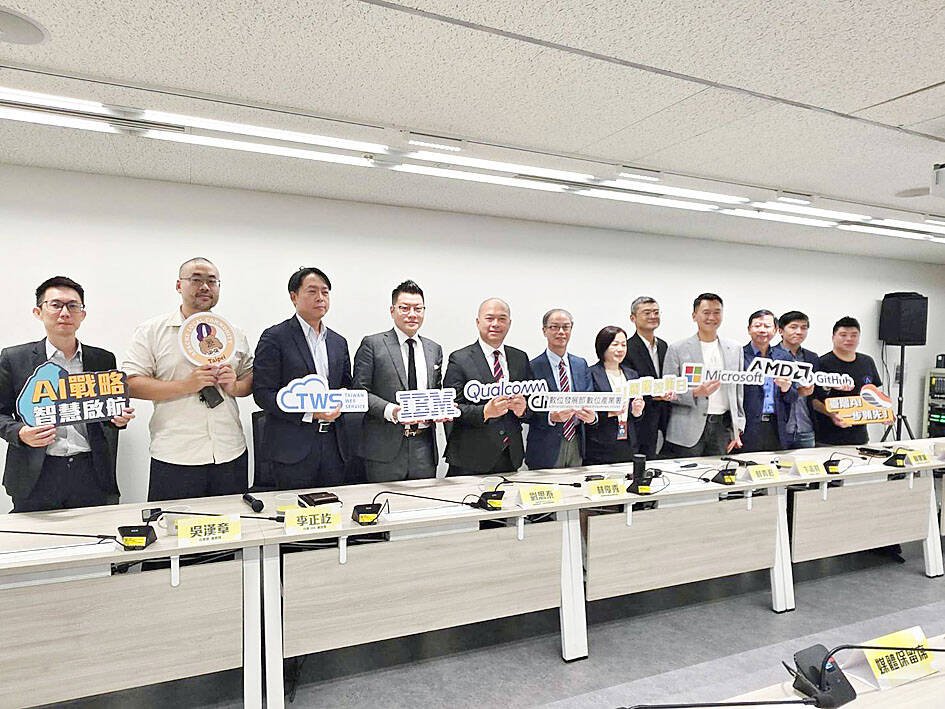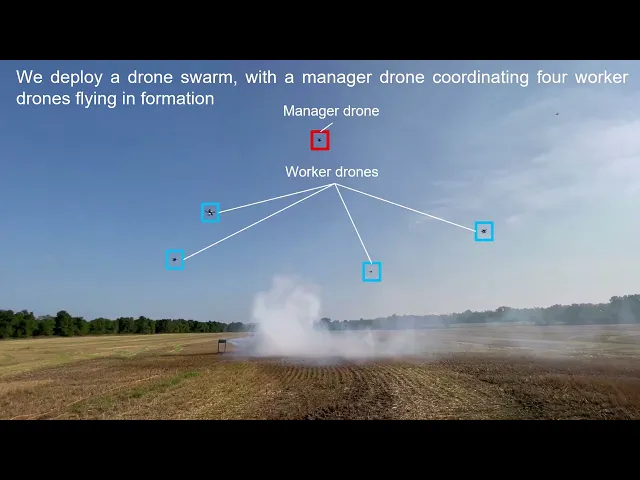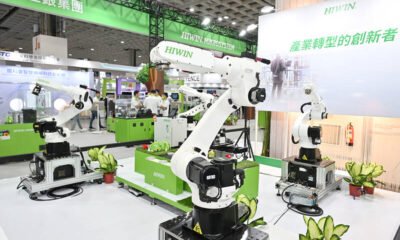Tools & Platforms
Taiwan partners with global titans to grow AI talent

The Ministry of Digital Affairs yesterday said it is partnering with global technology giants such as Qualcomm Technologies Inc, Microsoft Corp, IBM and Advanced Micro Devices Inc (AMD) to cultivate artificial intelligence (AI) talent in Taiwan.
Administration for Digital Industries Director-General Lin Jiunn-shiow (林俊秀) told a news conference that the ministry’s international partners would introduce the latest AI tools to Taiwan, helping local developers expand their skills and advance the nation’s AI capabilities.
“Taiwan stood on the shoulders of giants to develop its hardware industry,” Lin said, referring to the country’s collaboration with foreign firms. “Today, we are taking a similar approach to accelerate AI software and technology development in response to the boom of the AI era, as we recognize that talent is the cornerstone of AI infrastructure.”
Photo: CNA
S.T. Liew (劉思泰), vice president of Qualcomm and president of Qualcomm Taiwan and South East Asia, Australia and New Zealand, said at the event that generative AI has brought sweeping change worldwide and driven rapid technological upgrades.
AI has not only intensified competition in innovation, but also created tremendous business opportunities, he said, adding that cultivating sufficient talent is essential for Taiwan to compete in the AI era.
Economies of scale in AI development are expected to drive success in the new era, with the public and private sectors playing central roles, Liew said.
“We hope Taiwan would not only be a semiconductor island, but also an AI island,” he said.
Microsoft Taiwan general manager Sean Pien (卞志祥) said that since 2020, the company has run a digital talent cultivation program in Taiwan, training about 200,000 professionals over three years.
However, as the digital era shifts into the AI era, demand from industry continues to outpace supply, he said, adding that talent cultivation is the first step to compete in the AI era.
IBM Taiwan general manager Nelson Lee (李正屹) said enterprises must not only nurture AI talent, but also become “AI ready” across areas such as corporate culture, governance and technology platforms to achieve higher returns.
AMD Taiwan senior vice general manager Lin Chien-cheng (林建誠) said the company has launched diverse and open AI development platforms to give industries the flexibility to build AI systems suited to their needs.
Local AI communities — including Apache Taipei, GitHub Star, WordPress and idealNCU — have also teamed up with the ministry in AI talent and technology development.
Apache Taipei is to establish a new branch next month to train open-source software engineers in Taiwan, and strengthen links between the nation’s open-source groups and their global counterparts, the ministry said.
Tools & Platforms
How St. Joseph, Mo., Is Using AI Technology to Improve Streets

(TNS) — City leaders are eyeing the next generation of cutting-edge technology to help grade and improve the condition of St. Joseph’s streets and roadways.
St. Joseph Public Works and Transportation is in the process of integrating new AI-powered software called Road AI, a type of specialized road maintenance software capable of detecting defects from cracking and fretting to edge deterioration and larger potholes.
“We’re trying to advance everything in Public Works and AI is the big thing right now, St. Joseph Public Works and Transportation Director Abe Forney said. “This new technology will enhance the ability for our public works department to hit those potholes.”
A $15,380 contract for the new technology is set to be introduced for first reading at Tuesday’s City Council meeting and could be finalized later on Sept. 15.
The program operates by recording street surfaces using smartphones while an inspector drives the route. The video is uploaded nightly to a cloud-based AI program with condition ratings being available within hours.
Data is then exported to Excel and imported into Cartegraph — an operations and asset management software platform — for use in determining overlay lists, concrete repair lists and other maintenance priorities.
“It’ll also give us sign inventory that we’ve never had. So it’s looking at signs. It’s looking at our road conditions. It’s looking at crosswalks where they should be and bike trails that cross the road,” Forney said. “This technology is going to continue to grow.”
RoadAI’s technology will sharply boost efficiency and enhance the long-held process of having a supervisor drive and document 440 lane miles of roadway in St. Joseph.
If approved by council, Forney expects the city will be able to quickly integrate the new software and have it deployed for staff usage in short order. The software is part of a subscription service offered through company Vaisala Inc.
“Taking one of our employees and driving all the roads and him writing on a piece of paper what our road conditions are … this is going to be much better,” Forney said. “This technology is going to free them up to do other things that need attention.”
In the long run, he’s optimistic the AI-powered technology will provide cost savings for the department and could grow in usage in other areas. RoadAI’s website states the software is 50% less expensive that traditional road surveys.
The technology is one key part of the city’s new five-year street master plan, a strategy designed to address top concerns identified in a community survey launched earlier this year.
“The survey that just came out said that our road conditions are in poor shape. We all know that some of our roads need some attention,” Forney said. “There’s so many things that are out there that we can utilize to better our public works department.
© 2025 the St. Joseph News-Press (St. Joseph, Mo.). Distributed by Tribune Content Agency, LLC.
Tools & Platforms
AI-Powered Drones Help To Track Wildfire Smoke

Thank you. Listen to this article using the player above. ✖
Want to listen to this article for FREE?
Complete the form below to unlock access to ALL audio articles.
Researchers at the University of Minnesota Twin Cities have developed aerial robots equipped with artificial intelligence (AI) to detect, track and analyze wildfire smoke plumes. This innovation could lead to more accurate computer models that will improve air quality predictions for a wide range of pollutants.
The research was recently published in Science of the Total Environment, a peer-reviewed scientific journal.
According to a 2024 Associated Press report, 43 wildfires resulted from 50,000 prescribed burns between 2012 and 2021, creating the need for better smoke management tools.
Previous simulation tools have worked to model fire and smoke particle behavior, but there were still limitations in accurate collection of data, modeling and the current field tools to observe these smoke plumes. In this paper, the researchers addressed the challenges in accurately modeling how smoke particles behave and spread during wildfires and prescribed burns.
“A key step is understanding the composition of smoke particles and how they disperse,” said Jiarong Hong, a professor in the University of Minnesota’s Department of Mechanical Engineering and senior author on the paper. “Smaller particles can travel farther and stay suspended longer, impacting regions far from the original fire.”
Using a swarm of AI-guided aerial robots, they were able to capture multiple angles of the smoke plumes to create 3D reconstructions of smoke plumes and analyze flow patterns. Unlike traditional drones, these aerial robots can identify smoke and navigate into it to collect data.
“This approach allows for high-resolution data collection across large areas—at a lower cost than satellite-based tools,” said Nikil Nrishnakumar, a graduate research assistant with the Minnesota Robotics Institute at the University of Minnesota and first author of the paper. “It provides critical data for improving simulations and informing hazard response.”
The cost-effective technology has potential beyond wildfires and could be adapted for sandstorms, volcanic eruptions, and other airborne hazards. The team’s next goal is to translate the research into practical tools for early fire detection and mitigation.
“Early identification is key,” Hong said. “The sooner you can see the fire, the faster you can respond.”
Previously, the team developed an autonomous drone system, equipped with onboard computer vision and sensors to detect and track wildfire smoke plumes in real time. Building on this, they will now be focusing on efficient plume tracking and particle characterization using Digital Inline Holography with coordinated multi-drone systems. They are also working on integrating a type of drone, called a fixed-wing VTOL (Vertical Takeoff and Landing), that can take off without a runway and can fly for more than an hour for extended-range surveillance missions.
Reference: Krishnakumar N, Sharma S, Pal SK, Hong J. 3D characterization of smoke plume dispersion using multi-view drone swarm. Sci Total Environ. 2025;980:179466. doi: 10.1016/j.scitotenv.2025.179466
This article has been republished from the following materials. Note: material may have been edited for length and content. For further information, please contact the cited source. Our press release publishing policy can be accessed here.
Tools & Platforms
How Saia moves beyond AI hype to adopt technology
When Saia considers new technology for its business, it considers several key parameters. The LTL carrier carefully evaluates the tech investment, makes sure it delivers productivity, and fits into its customer first strategy, EVP and Chief Information Officer Rohit Lal told Trucking Dive.
“While we are extremely nimble and forward-looking, we are also careful to look beyond the hype before implementing AI, or any other new technology,” Lal said in an email.
Data, technology and new digital capabilities have caused a frenzy with new products and services, but LTL carrier Saia notes there must be a clear purpose to guide those additions.
Despite the downcycle, the carrier has invested in technology, part of a sweeping $2 billion overhaul for the company over the last five years, according to its latest annual report.
“We believe the investments we have made and continue to make in our network, technology and our people during this down cycle position us well for the future,” EVP and CFO Matthew Batteh said on a July earnings call.
Net capital spending for a technology/other line item rose to $64 million in 2024, up from $36.7 million and $33.4 million in previous years, the annual report noted.
That spending matters for Saia’s extensive network of shipments, trucks and trailers, the company noted.
For 2025 and 2026, tech investments are focused on “three key areas that directly impact our operational efficiency and customer experience: enhanced visibility across our network, improved predictive capabilities for capacity planning, and streamlined customer interfaces,” Lal said.
Other carriers have also implemented AI. XPO and ArcBest recently noted how they’ve used it to improve route planning, and Landstar System said in May it’s investing in the technology to help stop cargo theft.
But just because a technology is available doesn’t mean Saia will pursue it, officials said. Saia didn’t list any companies that it felt were doing the opposite of its strategy.
Regardless, Saia did say that every technology investment for the carrier is “carefully evaluated and must deliver tangible results, whether that’s improving productivity or meaningfully supporting our ‘Customer First’ strategy,” Lal said.
“What’s most important isn’t the technology, but the focus on capabilities that will compound our key differentiators of speed, reliability, and excellent customer service,” he said.
-

 Business4 days ago
Business4 days agoThe Guardian view on Trump and the Fed: independence is no substitute for accountability | Editorial
-
Tools & Platforms3 weeks ago
Building Trust in Military AI Starts with Opening the Black Box – War on the Rocks
-

 Ethics & Policy1 month ago
Ethics & Policy1 month agoSDAIA Supports Saudi Arabia’s Leadership in Shaping Global AI Ethics, Policy, and Research – وكالة الأنباء السعودية
-

 Events & Conferences3 months ago
Events & Conferences3 months agoJourney to 1000 models: Scaling Instagram’s recommendation system
-

 Jobs & Careers2 months ago
Jobs & Careers2 months agoMumbai-based Perplexity Alternative Has 60k+ Users Without Funding
-

 Funding & Business2 months ago
Funding & Business2 months agoKayak and Expedia race to build AI travel agents that turn social posts into itineraries
-

 Education2 months ago
Education2 months agoVEX Robotics launches AI-powered classroom robotics system
-

 Podcasts & Talks2 months ago
Podcasts & Talks2 months agoHappy 4th of July! 🎆 Made with Veo 3 in Gemini
-

 Education2 months ago
Education2 months agoAERDF highlights the latest PreK-12 discoveries and inventions
-

 Education2 months ago
Education2 months agoMacron says UK and France have duty to tackle illegal migration ‘with humanity, solidarity and firmness’ – UK politics live | Politics













